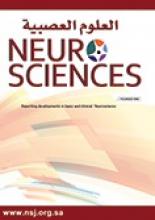Research ArticleOriginal Article
Open Access
Clinical and biochemical profile of Guillain Barré Syndrome in Pakistan
Rashid Iqbal, Muhammad J. Asad, Muhammad B. Shah, Raja T. Mahmood and Saima Siddiqi
Neurosciences Journal July 2021, 26 (3) 242-247; DOI: https://doi.org/10.17712/nsj.2021.3.20200178
Rashid Iqbal
From Arid Agriculture University (Iqbal, Asad, Shah), Rawalpindi, from Department of Biotechnology (Mahmood), Mirpur University of Science and Technology, Azad Kashmir, from Institute of Biotechnology and Genetic Engineering (Siddiqi), KRL Hospital, Islamabad, Pakistan.
PhDMuhammad J. Asad
From Arid Agriculture University (Iqbal, Asad, Shah), Rawalpindi, from Department of Biotechnology (Mahmood), Mirpur University of Science and Technology, Azad Kashmir, from Institute of Biotechnology and Genetic Engineering (Siddiqi), KRL Hospital, Islamabad, Pakistan.
PostDocMuhammad B. Shah
From Arid Agriculture University (Iqbal, Asad, Shah), Rawalpindi, from Department of Biotechnology (Mahmood), Mirpur University of Science and Technology, Azad Kashmir, from Institute of Biotechnology and Genetic Engineering (Siddiqi), KRL Hospital, Islamabad, Pakistan.
PhDRaja T. Mahmood
From Arid Agriculture University (Iqbal, Asad, Shah), Rawalpindi, from Department of Biotechnology (Mahmood), Mirpur University of Science and Technology, Azad Kashmir, from Institute of Biotechnology and Genetic Engineering (Siddiqi), KRL Hospital, Islamabad, Pakistan.
PhDSaima Siddiqi
From Arid Agriculture University (Iqbal, Asad, Shah), Rawalpindi, from Department of Biotechnology (Mahmood), Mirpur University of Science and Technology, Azad Kashmir, from Institute of Biotechnology and Genetic Engineering (Siddiqi), KRL Hospital, Islamabad, Pakistan.
PostDoc
References
- 1.↵
- 2.↵
- Yuki N,
- Hartung H-P.
- 3.↵
- Shang P,
- Zhu M,
- Wang Y,
- Zheng X,
- Wu X,
- Zhu J, et al.
- 4.↵
- Debnath M,
- Nagappa M,
- Murari G,
- Taly AB.
- 5.↵
- Wu X,
- Wang J,
- Liu K,
- Zhu J,
- Zhang H-L.
- 6.↵
- Wang Z,
- Zhang J,
- Mi J,
- Ma H,
- Zhao D.
- 7.↵
- Berciano J,
- Orizaola P,
- Gallardo E,
- Pelayo-Negro AL,
- Sánchez-Juan P,
- Infante J, et al.
- 8.↵
- Zeppelin Z,
- Kristensen S,
- Fuglsang-Frederiksen A,
- Andersen H,
- Harbo L,
- Levison L, et al.
- 9.↵
- Tunç A.
- 10.↵
- Van Koningsveld R,
- Steyerberg EW,
- Hughes RA,
- Swan AV,
- van Doorn PA,
- Jacobs BC.
- 11.↵
- Roth S,
- Spalinger MR,
- Gottier C,
- Biedermann L,
- Zeitz J,
- Lang S, et al.
- 12.↵
- 13.↵
- Maleb A,
- Bouayadi O,
- El Malki J,
- Rifai S,
- Lamrabat S,
- Benaissa E, et al.
- 14.↵
- 15.↵
- Zia MA,
- Masood Y,
- Salman MK.
- 16.↵
- 17.↵
- 18.↵
- Brettschneider J,
- Petzold A,
- Süssmuth S,
- Tumani H.
- 19.↵
- Nomani AZ,
- Iqbal M,
- Majeed H,
- Badshah M,
- Nabi S,
- Jan Z, et al.
- 20.↵
- Cetiner M,
- Seyit M,
- Akdağ G,
- Demirbaş H,
- Temel Ö,
- Kabay SC.
- 21.↵
- Shafqat S,
- Khealani B,
- Awan F,
- Abedin S.
- 22.↵
- Kalita J,
- Misra U,
- Das M.
- 23.↵
- Debnath B,
- Hussain ME,
- Haque N,
- Khan AAM,
- Mian MF,
- Islam MN, et al.
- 24.↵
- 25.↵
- Zhang B,
- Wu X,
- Shen D,
- Li T,
- Li C,
- Mao M, et al.
- 26.↵
- Webb AJ,
- Brain SA,
- Wood R,
- Rinaldi S,
- Turner MR.
In this issue
Clinical and biochemical profile of Guillain Barré Syndrome in Pakistan
Rashid Iqbal, Muhammad J. Asad, Muhammad B. Shah, Raja T. Mahmood, Saima Siddiqi
Neurosciences Journal Jul 2021, 26 (3) 242-247; DOI: 10.17712/nsj.2021.3.20200178
Jump to section
Related Articles
- No related articles found.
Cited By...
- No citing articles found.





